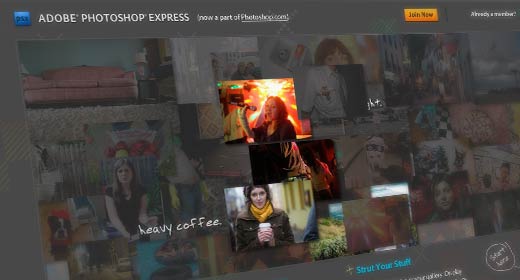Isn’t it funny? You spend hours upon hours staring at the software of Adobe, yet how often do you think to yourself that it might be worth exploring the Adobe website? Yeah, me either. Their software hides many pasages often left unexplored, only to be discovered one lazy afternoon, leaving you wondering how you didn’t know you could do whatever it is you just found. The website isn’t much different, so I thought I might provide a few shortcuts.
Video Workshop

The video workshop is a great place to learn a thing or two or five about the most common Adobe programs. From how to prepare files for output in InDesign to how to use the Vanishing Point in Photoshop, it’s a great spot to learn. The videos are provided by online-education super-power Lynda, so they’re of the high quality you’d expect from the pairing of the two companies.
Design Center

Think of the Design Center portion of the Adobe website as a hub for all that which is worth looking at. Split into four parts, the Design Center is really a starting off point. A starting off point that would do well to have an RSS feed.
Starting with the Gallery, which showcases the work of creatives from around the world (spoken about more in depth below), there is also Think Tank, Dialogue and Tutorials.
Think Tank is the thinking-creatives section. Providing meaty articles on creatives and how they use technology to develop their art, it works well as a trigger-presser for the senses. It’ll get you thinking, it’ll inspire, stun and leave you mumbling “… why didn’t I think of that?” Then there is the Dialogue section which for the last few months has mostly been resupplying articles from the now defunct Adobe Magazine (a PDF magazine with past issues still available) and if you go a little further back in the archives is more of a “hey, this is cool, check it out” type posts either showing tutorials, the always great HillmanCurtis videos, almost-random notes or articles ranging in lengths from 150 words to 500. And lastly, there is the Tutorials section which is disturbingly lack-luster and to be honest, not worth the trip.
Design Center – Gallery

Step into the gallery and set your senses to stunned. Wow, awful start. The Design Center Gallery is a great place to see the works of some very talented photographers, graphic artists and designers. For each designer there is a brief biography and an outline to accompany the work exhibited. There are of course a plethora of other online sources when it comes to this kind of showcasing. The reason I included it is because it shows how Adobe are (at least at some level) involved and a part of the community the provide to, not just on the outer ring looking in.
Workflow Guides

Ok, so CS4 is just around the corner for most of us, so this kind of thing isn’t going to be 100% up-to-date. We’re provided with a few PDFs (one for the Design, Web and Production suites) that are more like promotional flyers. There isn’t a wealth of information, but there are useful snippets to be found. Little reminders of what can be done and how the programs in the suite interact with one another and highlighted new features. The kind of thing you’ll look at early on after purchasing the software and might find worth flicking through again at some point.
Adobe on Delicious

Yup, Adobe have a Delicious account. Updated surprisingly often, it’s currently weighing in at 1385 bookmarks and can be found here. Mostly filled with tutorials, there are a good number of those 1385 bookmarks worth looking at.
The Adobe Exchange

The Adobe Exchange is a good place to find plugins and scripts for your Adobe applications. From whipping up a calendar in InDesign in a flash to clogs and toothed wheels Shapes for Photoshop, you’re bound to mostly find useless junk or something that’ll make your life so much easier. (I impressed my boss while doing work experience by using an InDesign multi-page PDF import script for CS2 found here. I got the gold star that day!)
Showcase

This is where the marketing team at Adobe get happy! Here you’ll find showcases of companies whom have used Adobe Programs to develop their products and marketing materials, saying nice things about Adobe. Oddly enough, it isn’t as boring as you’d think. Especially when you find the company you work for mentioned.
Edge Newsletter

Edge is bi-monthly newsletter produced by Adobe which relates to the web design arena. Free and online, it provides a rather comprehensive look at new technologies being developed by Adobe (natch), interesting web-based projects that have popped up and in-depth thoughts, rants and suggestions relating to the way creatives design for the web.
Design Schools

A resource site developed for students and teachers, this is one section of the site that might turn a few people off. You know, those arrogant people that assume once you’ve graduated, stolen your first copy of Photoshop or have under- or over-charged someone, you’re no longer a ‘student’. Those of us that realise we’re never going to stop being students and who want to learn something new or see what work is being produced by the industry leaders of tomorrow, this is a great little page.
ADAA

The Adobe Design Achievement Awards site is mostly what you’d expect for a competition site—guidelines, submission details and judges info. But there are two great parts of this site worth mentioning. Firstly, there is last years winners, whom provided some inspiring and interesting work. Then there’s the giant A, which is, frankly, awesome. It allows you to ‘see students around the world submit their competition entries in real time on ADAA Live!‘
Kuler

Kuler is Adobes way of making sure people stop using awful colour combinations. Simply browse randomly through the newest, most popular or most highly rated colour combinations and you’ll be flooded by wave after wave of beautiful colours. You can also punch in a keyword and get many combinations submitted by users.
The real power of kuler comes in when you start to use its Create section, where you are given the chance to develop your own combination of colours using colour guides (using a base colour), or, and this is the seriously-cool part, from a photo you either upload or find on flickr. When working on colours from a photo, you even have the option of letting the Kuler software pick the colours for you based on the range/mood you’re after (Bright, Muted, Dark, etc). Ohhhh yeah.
Brilliant

I’m not even sure where to begin with this one. This is a very special section of the site that has gotten a fair bit of attention recently because of CS4. It’s essentially marketing material, but shown in such a way that you can’t help but delve deeper and deeper into the site. From videos to small articles, you make your way around several 3D spaces to discover the content which lies in the creative landscapes.
Online Photoshop

Technically not on Adobe.com, but how far removed could you consider Photoshop.com? To sum it up, this is an online, stripped-back, version of Photoshop. There isn’t necessarily true editing capabilities, but that’s kind of the point. It’s an online space for you to put your photos (if you sign up, you will receive 2gb of storage) and lets you play with colour and lighting properties of your images.Documents

Through opening dusty doors and wandering passages behind bookcases the line the walls of Adobe.com, I stumbled over a few pieces work noting. PDF pieces that is. We have a colour workflow guide for CS3, a great document on typographic fundamentals which goes into detail about type clasification, sizing, alignment and a huge amount of other tips. Coolest of all, it uses a hedera for bullets! There is also a guide on how to use and output PDF files the best way possible and for those who like to read a word or two, a whitepaper on visual literacy.
Adobe Cards

To end on a high-note, we have Adobe Cards, a fantastic expression of creativity. This received a lot of attention a few months ago, so it might not be new to a lot of you, but if you’ve seen it before, see it again.
Master Your Craft.
Weekly.
Become the designer you want to be.
Join a group of talented, creative, and hungry designers,
all gaining the insight that is helping them make
the best work of their lives.